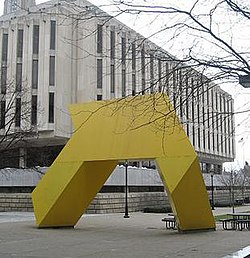History
In 1971, then-board-chairman of the Westinghouse Electric Corporation Donald Burnham commissioned Tony Smith for a piece of public artwork for the Gateway Center in downtown Pittsburgh. Light Up! was assembled with a crane on-site in 1974. With the help of University of Pittsburgh architect Ana Guzman, the sculpture was relocated to its current location on the University's campus. [4]
Although generally well received at the time of its dedication, [5] it was described as a disappointment by a news columnist for the Pittsburgh Post-Gazette for not being as "dynamic" as some of Smith's other works. [6]
Description
Light Up is 20 feet and 6 inches in height and most noted for it being a bright shade of yellow; a departure from the sculptor's more numerous black works. [1] It combines a tetrahedron and octahedron into what Smith described as a "continuous space grid" which "may be seen as interruptions in an otherwise unbroken flow of space." [1]
In its public settings it has been seen to be a stark comparison to the surrounding colors and shapes of its neighboring architecture, with one writer describing it in comparison to an adjacent Ludwig Mies van der Rohe skyscraper in its temporary New York retrospective setting as being "a jazzy counterpoint to its staid geometry." [7] For this reason some posit Smith's intention, for its original setting, was to lighten up its surroundings and perhaps the attitudes of passers-by. Although Smith acknowledged that the color provided warmth against the sculpture's original backdrop which was a dark building, Smith's actual inspiration came from his observation of yellow newspaper truck driving around Pittsburgh that he had witnessed from a vantage point on the Mount Washington overlook above the city's downtown. [8]
This page is based on this
Wikipedia article Text is available under the
CC BY-SA 4.0 license; additional terms may apply.
Images, videos and audio are available under their respective licenses.
